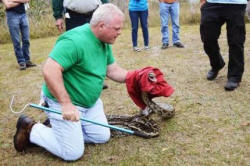|
 Florida
calls on civilian 'patrols' to battle invasive pythons Florida
calls on civilian 'patrols' to battle invasive pythons
 Send a link to a friend
Send a link to a friend
[February 03, 2015]
By Zachary Fagenson
MIAMI (Reuters) - Florida wildlife
officials, opening a new front in the war on invasive snakes, are
recruiting the general public for "python patrols" that teach them how
to identify and even capture some of the hissing, snapping reptiles.
|
|
 "We consider (Burmese pythons) established, which means the hope
of removing them is pretty slim," said Jenny Novak, a Florida Fish
and Wildlife Conservation Commission (FWC) biologist, during a
recent training session with 20 volunteers in south Florida. "We're
in management mode now." "We consider (Burmese pythons) established, which means the hope
of removing them is pretty slim," said Jenny Novak, a Florida Fish
and Wildlife Conservation Commission (FWC) biologist, during a
recent training session with 20 volunteers in south Florida. "We're
in management mode now."
On Sunday the volunteers spent an hour in a classroom learning how
to distinguish between invasive and native snakes and how to safely
capture and contain them.
Later, the group moved outside where coiled up pythons were released
and volunteers used poles to pin their heads, sometimes with mouths
agape, to the ground. They then grabbed the snake at the base of its
head and carefully maneuvered it into a bag sealed with electrical
tape.
"I'm not that worried about her," said Mark McCarthy, 63, as his
daughter, 29-year-old Keeley Philbrook, readied to grab hold of a
five-footer (1-1/2 meter).
She bagged it with some help from a fish and wildlife technician,
and still shaking afterward said she would not try it alone.
 Several classes are to be held monthly and officials say they hope
to train hundreds of volunteers.
After taking the class and applying for a permit volunteers can hunt
for snakes on some FWC-owned properties. Those who do so are
encouraged to turn snakes over to wildlife officials to be
euthanized or kept for research.
But officials are coming under fire from critics who say the public
should stay away from the non-venomous pythons, which kill by
constricting their prey.
"This is ridiculous," said Kenneth Krysko, a senior herpetologist at
the University of Florida. "You can't have Joe Schmo grabbing these
snakes."
Krysko said he thinks the civilian patrols will also be ineffective
in reducing the python population.
[to top of second column] |

Florida is a hub for the exotic pet trade and a hot bed of invasive
species that have snuck into the tropical environment. An estimated
150,000 Burmese pythons now occupy the state’s southern half,
according to officials.
Since the snakes were first spotted in the 1970s, they have become
top predators in the ecologically fragile Everglades, gobbling up
whole alligators and other native species, and growing more than 18
feet (5-1/2 meters) long.
The latest concern is a small population of aggressive North African
"rock" pythons several miles west of downtown Miami. Since they were
first discovered in 2001, 69 have been spotted and 29 have been
captured, according to Krysko.
Officials hope they have the rock pythons contained through what
Novak called an "an early detection, fast response program."
But Krysko said it is too little, too late after Burmese python
numbers mushroomed during decades when sales weren’t outlawed and
wildlife agencies had few programs to deal with unwanted pets or
snakes released in the wild.
(Reporting by Zachary Fagenson; Editing by David Adams and Eric
Beech)
[© 2015 Thomson Reuters. All rights
reserved.]
Copyright 2015 Reuters. All rights reserved. This material may not be published,
broadcast, rewritten or redistributed.
 |